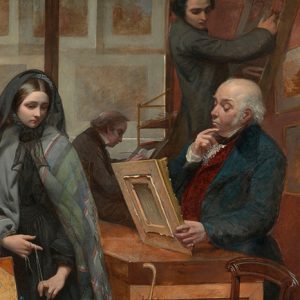Choosing A Gallery – this is the most daunting task for any artist new to the market and is crucial to success. To begin with, you should visit as many art fairs as possible and make good use of the Internet. You want to find galleries that would be a good fit for you and your work. If you are a representational artist, you probably will not have much luck if you approach a gallery that specializes in abstract or conceptual art… and vice versa. After you have found a group of galleries that might be right for you, the next thing is to do some research on each. Some things to consider are: How long have they been in business? What sort of reputation do they have? Which fairs do they attend? How do they promote themselves and their artists? How many artists do they currently represent? If you know any of the artists on their roster, it would be advisable to speak with them … they will likely have some great inside information about the gallery, the dealer, and the staff.

Emily Mary Osborn – Nameless and Friendless
While each individual artist has a unique set of criteria they are looking for when choosing a gallery, there are certainly a few key characteristics that apply across the board. Aside from simply finding a gallery that matches your aesthetic, you want to be sure that the galleries you are considering are well-established. In today’s art world, countless individuals seemingly wake up one day and decide to be a gallerist. Now, while some galleries that pop up become successful, many fail after just a short while, and the last thing you want is to have work consigned to a gallery while the owner is filing bankruptcy. I’ve seen and heard too many stories of artists having to fight to get their artwork back or, worse, never seeing them again. Further, simply because a gallery has been around a while does not mean they are necessarily someone you want to “get in bed with.” You want to find a gallery with a great reputation with both their collectors and their artists; as I mentioned earlier, reaching out to a currently represented artist will give you some great insight as to how things work at that gallery, particularly in relation to this point, and will definitely help make your decision easier.
Aside from the gallery’s history, you certainly need to evaluate who’s doing the most work for you. That is, the gallery should take advantage of every outlet they have at their disposal, such as a social media presence (Facebook, Instagram, etc.), magazine and digital advertising, art fairs and exhibitions, etc. The more eyes your work is exposed to, the more likely you are to find a buyer, so the scope of a prospective gallery is an important consideration. On top of that, the current roster of artists will tell you a lot about the gallery. Sure, a stacked roster shows they can attract top-level artists and garner interest from collectors, but if they have a huge roster of artists represented, how much time and attention can be devoted to you? As a new artist, the access to guidance and advice early on may be far more useful than the potential exposure of throwing yourself into the deep end and hoping for success. Remember, these career decisions can profoundly impact your life; it’s always best to have all the facts and make a well-thought-out and educated decision as you move forward.
Once you have narrowed down your list, you will want to prepare to contact the gallery and present your work—we will touch on that next month.
